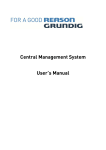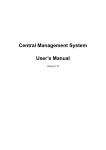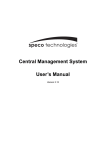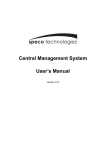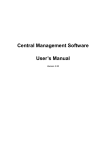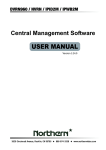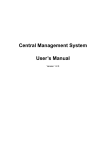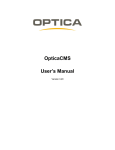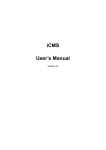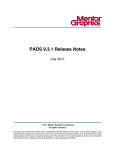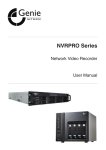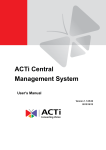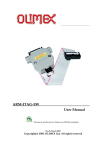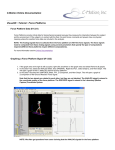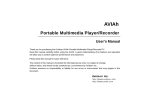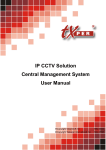Download Central Management System User`s Manual
Transcript
Central Management System User’s Manual Version 3.4.0 rel. date: 2/23/09 Optiview Inc. Table of Contents 1. Overview .......................................................................................................................3 1.1 System Requirement ...........................................................................................4 1.2 Supported IP Cameras ........................................................................................5 2. Software Installation.....................................................................................................6 3. Software Upgrade....................................................................................................... 11 4. Start the CMS ..............................................................................................................13 4.1 Starting Up .........................................................................................................13 4.2 Login..................................................................................................................14 5. Buttons Available on the Main Window ....................................................................15 6. Configure the CMS .....................................................................................................19 6.1 Setup Groups.....................................................................................................20 6.2 Manage the Sites...............................................................................................23 6.2.1 Add/Remove a Site ...............................................................................23 6.2.2 Setup the Site via Device Search..........................................................24 6.2.3 Setup the DVR Site Manually................................................................26 6.2.4 Setup the IP Camera Site Manually ......................................................28 6.3 Setup the File Path ............................................................................................29 6.4 Alert Events .......................................................................................................31 6.5 CMS User ..........................................................................................................35 6.6 Sequence ..........................................................................................................39 6.7 Login Setting......................................................................................................40 6.8 Network Setting .................................................................................................42 6.9 Log Data ............................................................................................................43 6.10 Export or Import Settings ...................................................................................44 7. Operation of the CMS.................................................................................................45 7.1 View Live Image / Assign Camera .....................................................................46 7.2 Camera Setting / Camera Info. ..........................................................................49 7.3 Display Mode .....................................................................................................51 7.4 Zoom In/Out Control via Mouse .........................................................................52 7.5 Sequence Display..............................................................................................53 7.6 Adjust the Image................................................................................................54 7.7 Playback Recorded Video..................................................................................55 7.8 Configure the OSD Menu of the Connected Site ...............................................61 7.9 Search for Event Videos ....................................................................................63 7.11 CMS Motion Detection.......................................................................................65 7.12 Object Search ....................................................................................................66 7.13 Take a Snapshot ................................................................................................68 1 User’s Manual 7.13 2-Way Audio Talk ...............................................................................................69 7.14 Instant Record Function.....................................................................................70 7.15 Dome Setting / Dome Control ............................................................................71 7.16 Schedule Record Function ................................................................................73 7.17 E-MAP Function.................................................................................................82 7.18 Health Function..................................................................................................86 7.19 Lock Function ....................................................................................................87 7.20 Joystick Control Function...................................................................................88 Appendix A: The CMS Player..........................................................................................90 Appendix B: Troubleshooting.........................................................................................96 2 User’s Manual 1. Overview The Central Management System (CMS) offers a simple and centralized monitoring interface for the video surveillance equipments. It gives the user access to monitor multiple DVRs, and allows the user to simultaneously monitor 64 sites per group (up to 10 groups) within several clicks. Features: z Monitor Multiple Sites - Supports up to 10 groups, each group can add up to 64 sites z Alert Function (LAN Only) - Sends live/event video clips and messages to the local computer from all connected DVR(s) z Connected Configuration - Configures the settings of the connected DVR(s) z Remote Playback – Allows the user to view recorded video stored in the connected DVR(s) z HDD Information – Displays information of all disk drives that are being used on the local computer z z Dome Control - Remotely operates the speed domes via the Internet Search (Devices) - Searches the LAN network for any available connected DVR z z Search (Video) - Searches the connected DVR for any recorded video Record - Records live or playback videos to the local computer 3 User’s Manual 1.1 System Requirement The following chart shows recommended computer system: Operating Systems Windows 2000, Windows XP, Windows Vista CPU Minimum: Pentium 4 RAM Memory Minimum: 512MB (Connects ≦ 32ch) Recommended: 1GB (Connects 64ch) Bandwidth Minimum: 256K Recommended: 1536K HDD Minimum 5GB HDD space is required if there is need to record video to the local computer. Video Card Recommended: Pre-installed with more than 64MB RAM 2.0GHz Recommended: Pentium 4 3.0GHz CPU: Intel(R) Core (TM)2 Quad CPU Q6600 @2.4GHz, RAM: 2GB, OS: WinXp, Display: NVDIA GrForce 8400GS 512M, Ethernet: Gigabit LAN, HUB: Gigabit HUB Tested Connection With the above system, the tested PC can stably connect up to 512 channels, which is the same as Extreme 32 units of 16-ch DVRs. NOTE: This system is required when 16 Megapixel IP cameras with 1280x960 resolution are going to be connected. NOTE: If the operating system is Windows Vista, some functions (such as Record, Auto Reboot, etc) will not work properly due to User Account Control (UAC). Follow steps below to solve this problem. Step 1. If a previous version of CMS is installed, export setting files of CMS servers (1~4) before installing the new version CMS. Step 2. Due to UAC, user account in Windows Vista cannot properly run applications that will write in “C:\Program Files\” folder. Therefore, CMS will be installed in “C:\” folder instead. Step 3. Once the new version CMS is installed, import the setting files back to CMS servers (1~4). 4 User’s Manual 1.2 Supported IP Cameras The following chart shows the models of IP cameras recognized by the CMS: Brand/Model Video Server MegaPixel IP Camera Streaming Protocol Video Stream Format Audio Stream Format HTTP RTP+RTSP (Intranet) RTP_Over RTSP (Internet) MPEG4 / MJPEG MPEG4 / MJPEG MPEG4 / MJPEG MS-ADPCM (2-Way Audio) g.711 a-law / g.711 u-law (2-Way Audio) g.711 a-law / g.711 u-law Adpcm / g.711 a-law / HTTP MJPEG / H264 RTP+RTSP MJPEG / H264 g.711 a-law / g.711 u-law AXIS 200 Series RTP/RTSP MPEG4 Unsupported VivoTek 7000 Series RTP/RTSP MPEG4 Unsupported Sony g.711 u-law NOTE: Each group can only connect to at most 16 IP cameras. 5 User’s Manual 2. Software Installation After acquired the installation file, follow the steps below to install the CMS to the local computer. Step 1: Double click the zipped file to unzip it. Step 2: There are 3 ways to start the installation. Option 1: After the zip file is opened, click on the Setup.exe file to start the installation. Option 2: After the zip file is opened, click on the AutoRun.exe file to start the installation. Option 3: If the program will be installed using the CD, the installation will run automatically when the CD is inserted into the CD-Rom. If the installation will be started either via Option 2 or Option 3 of Step 2, the <CMS Setup Menu> window will be displayed. Choose <INSTALL CMS> to start installing the CMS. Choose <CMS USER’S MANUAL> to open the user’s manual. Choose <EXIT> to exit the <CMS Setup Menu>. NOTE: If an older version of the CMS had been installed in the local computer, a message box will be shown during the installation. Click <OK> to uninstall the previous version. 6 User’s Manual After clicking <OK>, an <CMS Installation Uninstall: Confirmation> dialog will be displayed. Click <Uninstall> to uninstall the older version and continue with the next step. Step 3: Select the components that are going to be installed. It is strongly recommended to select the <Start Menu Shortcuts> to create shortcuts in the Start Menu and on the Desktop. Otherwise whenever the program is to be opened, it will have to be found under the path: “\CMS\EXE\CMS.exe”. Click <Next> to go to next step. The components of the CMS Installation Setup: : The CMS main program (Default). : Check to create shortcuts in the Start Menu and on the Desktop. : Check to install the NTP (Network Time Protocol) Server. : Check this box to load default setting, or uncheck it to load the old setting of previous installed CMS. 7 User’s Manual Step 4: The CMS main program will be the first program to be installed. Choose a folder to install the CMS or it will be installed to the default destination folder “\CMS\”. Click <Install> to start the Installation; or click <Back> to go back to the previous step. NOTE: If the PC has not installed “Microsoft Visual C++ 2008 SP1 Redistributable Package (x86)”, an alert message will be shown as below. Click <OK> and the installation will be terminated. Access the following link: http://www.microsoft.com/downloads/details.aspx?FamilyID= a5c84275-3b97-4ab7-a40d-3802b2af5fc2&DisplayLang=en and click <Download> to download and install it. Step 5: The NTP Server will be the next program to be installed. The NTP Server enables the local computer, which is running the CMS, to become a central NTP Server for the connected DVR(s) so the time for the local computer and the connected DVR(s) is synchronized. Click <OK> to start installing the NTP Server. 8 User’s Manual Step 6: Click <Close>, and the Software Installation is complete. NTP Service (Server) The NTP Service (Server) enables the local computer, which is running the CMS, to become a central NTP server for the connected DVR(s) so the time for the connected DVR(s) and the local computer is synchronized. To do so, the IP address of the local computer is needed. Go to Start menu, select Run. Type in cmd and click OK. 9 User’s Manual Type in ipconfig to get the IP Address of the local computer. Write down the IP address on a piece of paper for later use. After the IP address is found, setup the connected DVR(s). First, go to <Main Menu> Æ <System Setup> Æ <Date/Time> Æ <Time Zone> to setup time zone. To find out the local time zone, please visit www.greenwichmeantime.com NOTE: The <Time Zone> must be set or the <Network Time Protocol Setup> will not be accessible. After entered the local time zone, the <Network Time Protocol Setup> option will be accessible. Go to <Main Menu> Æ <System Setup> Æ <Date/Time> Æ <Network Time Protocol Setup>, and the following menu will be displayed. Network Time Protocol Setup 1. NTP Server time.nist.gov 2. Automatically Time Sync ON 3. Manually Time Sync No In this example, the NTP server should be set to “192.168.7.122” which is the IP address of the local computer. After the NTP server is set, select <Manually Time Sync> to sync the time with the local computer. The time sync can also be updated periodically. Select ‘ON’ for <Automatically Time Sync>, and the time will be automatically synced once an hour. 10 User’s Manual 3. Software Upgrade The CMS will automatically connect to the FTP Server and check for upgrade every once a month. If no upgrade is available, the CMS will continue normal process. If upgrade is detected, please follow the steps below to proceed. Step 1: A message box will pop up to inform that there is upgrade available. Click <OK> to download the upgrade software and continue to the next step. Otherwise, click <Cancel> to abort and continue to normal CMS process. Step 2: Choose a destination folder to save the file. Then a window will pop up and show the downloading status. Click <Abort> to terminate the download and the CMS will be started as usual. Step 3: When the download is completed, the installation of the new version of the CMS can be started following the same procedures described in the Software Installation section. 11 User’s Manual NOTE: If the upgrade file is not completely downloaded, an error message will be displayed as below. NOTE: A release note will also be downloaded together with the setup file. The following message will be displayed to show the file path where the release note is saved. 12 User’s Manual 4. Start the CMS There are 3 ways to start the CMS. Note that method A and B are only available if the “Start Menu Shortcuts” component is installed. Please see section Software Installation for more information. Method A: Click Start menu and select Programs; find “CMS” from the listed programs. Method B: Double click on the shortcut icon on the desktop. Method C: Go to “\CMS\EXE\” and double click on the CMS icon. 4.1 Starting Up If the CMS is started for the first time, select a desired language for the interface. The available languages are listed in the scroll box. Click <OK> to confirm the selection. If the system memory or CPU frequency is less than the requirement, the error message shown as below will be displayed. The following message will be shown if the setting file is blank or broken. 13 User’s Manual 4.2 Login The default User Name & Password are listed below. User Name: admin Password: 1234 Check <Save user name and password> to save time from entering username and password every time the CMS starts. Click <OK> to login. The username and password accounts can be added or removed under the <CMS User> tab in <Setting> configuration window. Refer to the CMS User section for more information. NOTE: If the wrong username or password is entered for 3 times, the message below will be shown, and the CMS will be closed automatically after <OK> is clicked. Reopen the CMS to enter the correct username and password. 14 User’s Manual 5. Buttons Available on the Main Window After starting the CMS, the main window of the CMS will be shown as the figure below. The name of each button is indicated as follows. 1 Display Modes: 2X2, 3X3, 4X4, 5X5, 6X6, 7X7, 8X8, Sequence, Full Screen 2 Left to Right: Live, Playback, CMS Player, Snapshot, Emap 3 Left to Right: Schedule Record, Setting, Health, Lock 4 Site Tree 5 Bandwidth, Audio 6 HDD Info The usage and function of each button will be briefly described as follows. Display Mode Click on any <Mode> icons to view the image in a multiple window mode. The selections include 4-window, 9-window, 16-window, 25-window, 36-window, 49-window, and 64-window modes. Refer to section Display Mode for more details on operation. 15 User’s Manual Click on <Sequence> to start displaying the sequence list. See Sequence Display section for more detailed information. Click on <Full Screen> to extend the current viewing grids to full screen. Hit <Esc> to exit. Live Click on the <Live> icon to view the live video. Note that after viewing recorded video, this button needs to be clicked to switch back to the live mode. Playback Click on the <Playback> icon to view recorded video stored in the HDD of the connected DVR. Please refer to Playback Recorded Video section for more information about playing back the video. CMS Player Click on the <CMS Player> icon to open the CMS Player. The CMS Player is a compact version of the standard DVR Player. Please refer to the Appendix A for more information. Snapshot Click on the <Snapshot> icon to save a snapshot of the current window(s). Refer to section Take a Snapshot for detailed information. Emap Click on the <Emap> icon to open the E-Map program. The E-Map is a program that allows the user to illustrate the positions of the cameras on a self selected image. Schedule Record Click on the <Schedule Record> icon to schedule the recording time frame for the sites. Setting Click on the <Setting> icon to set up the configuration. Refer to section Configure the CMS for detailed information. 16 User’s Manual Health Click on the <Health> icon to see the HDD information of the connected DVR(s). The data will be updated every 5 minutes. The following figure is an example. See Health Function section for more detailed information. NOTE: If more than half of the connected devices are not our products, a warning message as below will be shown and the CMS will be closed automatically. Lock Click on the <Lock> icon to lock the CMS to protect the works on the CMS when the user needs to be away from the computer for a while. This function is the same as the computer’s screensaver. See Lock Function section for more detailed information. Site Tree Displays the site(s) that are currently being viewed. If the connection to a certain camera is failed, there will not be image displayed on its assigned grid. Right click on the “site” and click <ReConnect> to try to establish the connection to the site. The <DisConnect> option allows the user to only disconnect a certain site. 17 User’s Manual The user can also rename the camera directly by right clicking on the camera and selecting <Rename>. The new name will be shown on the upper left corner of the camera’s assigned grid. Note that group and site cannot be renamed at the site tree. By right clicking on the group icon, the options shown as on the right allows the user to expand or collapse the site tree. Bandwidth & Audio Click to choose bandwidth option. Choose <High> when the internet speed is fast; and <Low> when the network is congested. Next to the bandwidth option is the audio button. Click to turn on/off the audio. NOTE: Turning ON/OFF the audio on CMS will not affect the audio setting of the connected DVR(s). HDD Info The pie chart on the bottom left displays the HDD information. This is especially useful when the user uses the CMS to record the video to the local computer. Scroll down the menu to see the information of all the HDD(s) installed on the local computer, such as C drive, D drive…etc. The blue part of the pie chart indicates the used space, and the yellow part indicates the available space. The information will be updated every 30 seconds. If file circular is enabled, the circulation will as well be updated every 30 seconds. 18 User’s Manual 6. Configure the CMS The CMS supports up to 10 groups, and at most 64 sites can be added to each group. The following sections guide you to setup your CMS step by step. Click on the <Setting> icon and the figure below will be displayed. NOTE: The configuration in “Group” tab and “Import” function will be unable to be saved when the CMS is detecting network connection or is connecting to some sites. Error messages will be shown to inform the users. 19 User’s Manual 6.1 Setup Groups Up to 10 groups can be set in the CMS. This section guides the user to add or remove a group, and also shows the user how to set “start group”. Add a group Click button to add a group. Double click on the group to rename it. The other way to add a group is to right click on <Groups>, and select <Add a group>. 20 User’s Manual Set Start Group “Start Group” is the group that will be connected after starting the CMS. Right click on the group to be set as “start group”, and select <Set as start group> from the pull-down menu. NOTE: If a group is set as the “start group”, the icon will be changed as shown in the figure below. 21 User’s Manual Expand/ Collapse a Group There are two ways to expand or collapse a group. One way is to use the buttons; the other way is to right click on the group and select <Expand> or <Collapse> from the pull-down menu. Remove a Group To remove a group, click on the group to be removed, and then click the button directly to remove the group. The other way to remove a group is to choose <Remove> after right clicked the group. 22 User’s Manual 6.2 Manage the Sites The following sections are instruction of the management of the sites, including add or remove sites and configuration. 6.2.1 Add/Remove a Site This section describes how to add or remove a site. Up to 10 groups can be created with a capacity of 64 sites. Add a site Choose a group to add a new site. Click the button to add a site to this group. The next section will show how to setup the site step by step. The other way to add a new site to a group is to right click on the group, and select <Add a site>. 23 User’s Manual Remove a site To remove a site, click on the site that is to be removed, and click the button directly to remove the site. The other way to remove a site is to right click on the site, and select <Remove> from the pull-down menu. A new site can either be a DVR or an IP Camera, and the number of sites equals to the number of the DVRs and IP Cameras. The following sections will show how to setup configuration of the sites. 6.2.2 Setup the Site via Device Search There are two ways to setup a site. The simple way is via Device Search. The CMS is able to search for the IP address of the DVR(s) or IP Camera(s) connected to the LAN. The ports used for device search are 6666 and 6667. Please make sure that these two ports are not in-use nor blocked by firewall or virus scan software. 24 User’s Manual Follow steps below to search for DVR(s) or IP Camera(s): Step 1: If there is a LAN network, the CMS can search the LAN network for IP address of available DVR(s) and IP Camera(s). Click the Search button (on the bottom right) to open the Search window. Step 2: Click <Refresh> to find the IP address of DVR(s) or IP Camera(s) available in the LAN network. Select from the list and Double click on the IP address to add it to a site. Then enter the username and password of the site. NOTE: The Device Search function can only be used to search for addresses within the same LAN. For example, if the local computer uses an IP address of 192.168.1.5, and a connected DVR has an IP address of 192.168.1.7, the CMS will be able to find the IP address of the DVR. However, if there is another DVR connected to another LAN network such as 192.168.3.6, the CMS (whose IP is 192.168.1.5) will not be able to find the IP address of the DVR in another LAN network. Search UPnP devices: Check the box in front of “Search UPnP Devices” and click <Refresh> to start searching for UPnP devices within the LAN. While the search is in process, <Refresh> button and “Search UPnP Devices” option will be grayed out and cannot be clicked or selected, in addition the window cannot be closed. <Refresh> button will be changed to <Search UPnP> to remind the user of the status. Everything will work only after the searching process is done. If the user double clicks on the list or tries to close the window, a warning message will be shown. 25 User’s Manual 6.2.3 Setup the DVR Site Manually If the detailed information (IP address, port, username, and password) of the connected DVR is provided, a site can be setup manually. Add a new site and enter the Name, IP address, Port, Username, and Password. Select “DVR” and click <OK> to complete the setting. NOTE: If the entered Username and Password is a user account instead of an administrator account, the same DVR account restriction will be applied. When a user account accessed a function that is restricted, the following message will be shown: 26 User’s Manual If the DDNS information of the DVR is known, the DDNS data can be used to setup a site. Check the box <(D)DNS> circled below, and type in the DDNS data. Click <OK> to complete the setting. An example of the DDNS address looks like: *******.ddns.iview-ddns.com NOTE: Port number does not apply to DDNS entries. Therefore, if the <(D)DNS> box had been checked, the port number does not need to be changed. 27 User’s Manual 6.2.4 Setup the IP Camera Site Manually If an IP Camera is going to be added to the CMS, the required information includes the IP address, port, username, password, and brand/model type of the IP Camera. Enter the data and select “IP Camera” as circled below. Then choose the <Model> and <Stream Type> of the IP Camera. Click <OK> to complete the setting. Supported IP Cameras: Brand/Model ACTi Streaming Protocol Video Stream Format Audio Stream Format HTTP Vivotek RTP+RTSP (Intranet) ................... RTP_Over RTSP (Internet) MPEG4 / MJPEG MPEG4 / MJPEG MPEG4 / MJPEG MS-ADPCM (2-Way Audio) g.711 a-law / g.711 u-law (2-Way Audio) g.711 a-law / g.711 u-law Adpcm / g.711 a-law / HTTP MJPEG / H264 RTP+RTSP MJPEG / H264 g.711 a-law / g.711 u-law AXIS 200 Series RTP/RTSP MPEG4 Unsupported VivoTek 7000 Series RTP/RTSP MPEG4 Unsupported Sony g.711 u-law NOTE: Each group can only connect to at most 16 IP cameras. 28 User’s Manual 6.3 Setup the File Path The file path menu defines stored destination of snapshot, archive files, and recorded videos. It is recommended to use the default folders. Record Path The recorded videos can be stored in more than one folder. Click on <Advance> and the following window will be shown: The number of selectable folders equals to the number of HDDs the PC connects to, excluding HDDs with capacity less than 1GB. Check the “Enable” box and click <Browse> to set more destination folders. Each folder should be from different HDD or an error message will be displayed. Note that if a HDD with less than 1GB capacity is selected, an error message will be shown. Click on <Clear All> will delete all folders except the first preset folder. 29 User’s Manual In each folder, subfolders will automatically be created with folder name “RecordFolder********”, which ******** represents an 8-digit serial number. Each subfolder can stores up to 500 videos. Once a subfolder is full, a new subfolder with a subsequent number will be created and new files will be stored to the new subfolder. Circular Function The <Circular> function is used to adjust the HDD space usage of the CMS. For example, when the threshold is set to 1GB, and there are 20GB free disk space remaining in the HDD, CMS can only access the HDD no more than 19GB. When the free disk size is smaller than threshold: 1. If the circulation of files is performed at first time, CMS will start to overwrite the earliest recoded data. Next time when CMS starts up, the circulation of files will continue from where it was up to. 2. If the destination folders are reset, new files will be stored to the first folder. If the first folder contains DRV files, all old files will be rewritten with new files until the folder is full. Record Videos from IP Cameras to Remote Network Disks When videos from IP cameras will be recorded to a remote network disk, the DRV file is going to be stored under a temporary folder “\CMS\TEMP_REC\” if the file size is less than 100MB. Once the file size reached 100MB, the file will automatically be transfer to the designated remote network disk. If the recording is interrupted (either connection reset, disconnected, stop recording, etc), a progress bar will be shown to inform the user that the DRV file is being transfer to the the designated remote network disk. NOTE: For CMS servers 2~3, the temporary folders will be name TEMP_REC2, TEMP_REC3, and TEMP_REC4. Snapshot Type The CMS has a snapshot function, and the file type for snapshot can be defined here. Note that if more than one type are selected, take 2 types for example, then each snapshot is saved to 2 types of files. They are the same image, but in different formats. For instance, if Bmp & Tif are selected and the snapshot is taken, two types of image files of the same snapshot image will be created. 30 User’s Manual 6.4 Alert Events The alert function enables the connected DVR(s) to send alert signals to the CMS within the network. This section describes how the alert function works. Setting up the alert function: Step 1: Find the IP address of the local computer. Go to Start menu, select Run. Type in cmd and click OK. Type in ipconfig to get the IP Address of the local computer. Write down the IP address on a piece of paper for later use. 31 User’s Manual Step 2: Setup the <Alert Notification Setup> on the connected DVR(s). The <Alert Notification Setup> allows the user to send alert notifications to the CMS program which had been installed to the computer. Alert Notification Setup 1. Alert Configuration Set 2. Alert Notification 3. Alert IP 4. Alert Port 5. Alive Interval 1 OFF 192.168.7.122 9999 120sec - Alert Configuration Set <Alert Configuration Set> provides 3 combinations of Alert Notification, IP, and Port. The user can match the connected DVR to at most 3 different CMS servers. - Alert Notification 4 options are included in this item; <OFF>, <Event>, <Alive>, and <Both>. <OFF>: The Alert Notification is turned off. <Event>: When the alarm is triggered, the DVR will send an alert message to the CMS. <Alive>: The DVR will send an alive message to the CMS every N second just to show that the connection between the DVR and CMS is in effect. The time interval N can be adjusted in <Alive Interval>. <Both>: This enables the DVR to send both Event and Alive alert messages to the CMS. - Alert IP The Alert IP must match the IP address of the local computer. In this example, the IP address of the local computer is 192.168.7.122. - Alert Port The Alert Port is the port used for sending and receiving alert signals. Choose any port that is not restricted by the network. The ports for both connected DVR and the CMS Alert must be the same. In this example, the port is set to 9999. NOTE: If 2 configuration sets are corresponding to 2 different CMS servers, each CMS server must have its own unique port number. 32 User’s Manual - Alive Interval Time interval (1 to 255 sec) between each alive message can be set here. Step 3: Setup the Alert of the CMS. Click on the <Setting> icon and go to Event tab to setup the port. Port 9999 is used in this example. Select ON to enable the alert function and click OK. <Event Full Screen> is used to display full screen of the alerted channel. Select <ON> to activate this function, or <OFF> to deactivate it. <Event Recording Duration> is for users to define recording duration of event videos, when schedule is set and/or when motion recording is enabled. NOTE: If the user reconnect or disconnect the sites, the list of the event full screen will be cleared. NOTE: Once the list of the event full screen finished playing, the window will return to former viewing status. Step 4: Alert Action The connected DVR sends 4 types of alert message (State) to the CMS: Alive, Alarm, Motion, and Video Loss. Alive messages are sent when the notification option is set to <Alive> or <Both> in the connected DVR. Alarm, Motion, and Video Loss messages are sent when the notification option is set to <Event> or <Both> in the connected DVR. 33 User’s Manual Viewing the alert events: When the alert is triggered while the alert function is turned on, an icon will be shown in the system tray to indicate that an alert is being triggered. Right click on the icon and the menu as shown on the right will be displayed. z Choose <Alert Info> to show the following window. Alternatively, double click on the icon can also display the Alert Info window. z Choose <Exit> to remove the icon from the system tray. NOTE: The maximum number of items can be kept on the alert list is 1,000. When the list reached 1,000 items, the earliest alert messages will be deleted while the new ones are being saved. Double click on the Event Messages (Alarm, Motion, or Video Loss) to view the event video in full screen. If the DVR sending the Event Messages is not currently connected to the CMS, a message box will be displayed as the following. Connect the DVR and the event video will be available. NOTE: The Alert function works ONLY within LAN network. (Please refer to the note of the Search function) NOTE: If the alert event has not yet been added to the database of the DVR, a warning message will be shown to notify the user. 34 User’s Manual 6.5 CMS User The <CMS User> is for the management of user accounts in the CMS. You can set users’ account information and privileges. The default username and password are: Username: admin Password: 1234 NOTE: Only users under the <Admin> group have the privilege to change the settings in <CMS User>. To add a user, you must first add a group. Right click on <User List> and select <Add Group> from the pull-down menu. 35 User’s Manual After the group is added, the first user account of the group will also be created. You MUST set the password for this account before you can go to the next step. Right click on <NewGroup01> to add a user, remove a group, or rename the group. NOTE: The account currently used to login cannot be deleted. 36 User’s Manual Right Click on <Group01User01> to remove a user or rename the username. The <Group Attribution Setting> is for setting up the privileges of the selected user. You can give each user account different privileges by configuring this function. 37 User’s Manual After entering the <Group Attribution Setting>, the following diagram will be shown. Select a user account in <Select CMS Group>, and you can click on the buttons to enable or disable its privileges. Purple buttons are CMS menu controls including: Playback, CMS Player, Emap, Schedule Record, Setting, and Lock. Gray buttons are site controls including: ReConnect/DisConnect, Record, Configuration, Event Search, and Camera Setting. Yellow buttons are camera controls including: Sequence, Rename, Dome Setting, Dome Control, Remove, and Sound Notification. Each camera can be set to enable/disable Live, Play, or Record function individually after clicked on <Advance Setting>. Refer to the following figure for details. NOTE: The preset is 16 cameras for all sites. The real number of cameras per each site will not be detected. NOTE: These settings will affect the whole operation of the CMS. Please be very careful while configuring the settings. Next time when you login, you can choose to enter the CMS either as the admin or the user. 38 User’s Manual 6.6 Sequence This function is used to set the displaying sequence. Before starting sequence display, you need to add channels to the sequence list. Right click on any channel and select <Add to Sequence> to add, or <Remove from Sequence> to remove. Note that when the channel is added to the sequence, a capital “S” will be shown on the icon. After the channels are added to the sequence, click on the <Setting> icon and choose <Sequence> to setup the sequence. Under the <Sequence Setup> option, you can setup the dwell time (1 to 120 seconds), and split mode (2*2, 3*3, 4*4, or 5*5). <Sequence Order> lists the channels that have been added to the list in order. Click <OK> to save the settings. Click <Clear Sequence List> to empty the list. A message window will be shown for confirmation. 39 User’s Manual 6.7 Login Setting The user can edit options regarding login settings in this section. Administrator username and password is required to edit the setting. As shown in the above picture, the box marked “1” is where the user can enter a set of username and password to be used for auto login. The “Verify” button can help the user to check if the username and password are correct. The following messages boxes will show to inform the result of verification. Correct 40 Wrong User’s Manual The box marked “2” contains the options regarding automatic actions. Clicking the first option “Start CMS when I start Windows” to request the computer to open CMS in the mean time when the system startup. Note that the other two options “Auto Login” and “Auto retrieve Live image When Login” will be checked at the same time. Nonetheless, it is still the user’s choice to determine the favorite setting. The following message will be shown when the CMS is auto opening after the system started up. Click “Cancel” can terminate opening the CMS. Click the second option “Auto Login” to automatically login when the CMS starts. Remember to enter and verify username and password in box 1. Click the third option “Auto retrieve Live image When Login” to automatically connect to the sites in the start group when the CMS starts. Detection of internet connection will be performed before hand and the following message will be displayed. Click <Stop> to terminate the detection and AutoLive will not be initiated. 41 User’s Manual 6.8 Network Setting The CMS provides the option of connection via proxy server for Optiview DVRs. Click <Network> tab and the setting items are shown below: If you wish to create the connection via a proxy server, check the box “Use a proxy server for your CMS connection.” Then enter the IP address and port of the proxy server. Enter username and password if authentication is required. NOTE: The CMS supports the most common authentication keys “Digest” and “Basic”. The authentication will be automatically detected and performed. Check the box “Bypass proxy for local address” to disable connection via the proxy server for local LAN network. The <Advance> button allows the user to edit an exception list where addresses in the list will not be connected via the proxy server. The addresses can be subnets. Refer to the picture on the right for an example of the exception list. NOTE: All functions of the proxy server are tested with the most common “Squid Proxy Server”. Some other proxy servers may not work properly. 42 User’s Manual 6.9 Log Data The step by step operation of the CMS will be recorded by the CMS log function. Refer to the following picture for data kept in the log file. The list will display 1,000 items with latest ones shown at the bottom. The list can store up to 10,000 items in circulation, which means the oldest ones will be deleted when the number of items exceeds 10,000. Save button: Click this button to save the log file to a desired destination. Previous button: Click this button to show previous 1,000 items. Next button: Click this button to show next 1,000 items. 43 User’s Manual 6.10 Export or Import Settings The export/import function provides users the option to backup the settings as needed. To export the configuration, click <Export> and select a directory to save the *.zip file. To import a previous saved configuration, click <Import> and find the *.zip file that was previously saved. NOTE: After a setting is imported and saved, the imported setting will be loaded immediately and the CMS will reconnect to the sites in the live group. 44 User’s Manual 7. Operation of the CMS There can be at most 4 CMS instances opened simultaneously. If the PC is connected to more than one monitor, for example 4, then the PC can open up to 4 CMS instances at the same time on the 4 monitors respectively. However the processor and RAM of the PC will limit the number of CMS instances as well. Note that all monitors have to be set to the same resolution. CMS multiple instances limitation according to the PC: Dual Core or Hyper-Threading Single Core and Frequency > 2.0GHz Single Core and Frequency ≤ 2.0GHz RAM ≥ 512MB Open 1 CMS RAM ≥ 1GB Open up to 2 CMS RAM ≥ 1.5GB Open up to 3 CMS RAM ≥ 2GB Open up to 4 CMS RAM ≥ 512MB Open 1 CMS RAM ≥ 1GB Open up to 2 CMS RAM ≥ 1.5GB Open up to 3 CMS RAM ≥ 2GB Open up to 4 CMS RAM ≥ 512MB Open 1 CMS NOTE: It is recommended to keep the connected channels within 512 channels if multiple CMS instances are opened. Network Connection Detection CMS will auto detect network connection status. If CMS lost network connection, the following error message will be displayed. When CMS detected the restore of network connection, the error message will disappear. Click on <Stop> to cancel this function. 45 User’s Manual 7.1 View Live Image / Assign Camera The user can view live video or connect to the connected DVR using the live button. Click on the <Live> button to see the live view. Connect/Reconnect/Disconnect the Sites If the connection between the CMS and the connected DVR has been interrupted, you can reconnect to it by right clicking on the Site, and select <ReConnect> from the pull-down menu. You can also disconnect specific sites by selecting <DisConnect> from the pull-down menu. Auto Detection of Disconnected Sites: The CMS will automatically detect if any sites that are connected at the beginning are disconnected for some reason later on in every 3 minutes. A list will be shown (as on the right) when there are sites detected to be disconnected. The list can be saved as a TXT file by clicking on <SAVE> at bottom left. NOTE: Besides auto-reconnect, a progress bar will be displayed as below. The connecting process will take at most 30 seconds. 46 User’s Manual Auto-Reconnect of Specific Disconnected Sites: The CMS will automatically reconnect to specific disconnected sites every 7 minutes. Refer to the following table for all cases. Situation Auto-Reconnect Sites that are not connected at the beginning: Yes Sites that are disconnected manually No Sites that are connected at the beginning but disconnected for some reason later on Yes Assign a Channel/Site to Certain Window(s): The CMS allows you to assign any channel/site in the site tree to any grid of the CMS main window. Follow steps below to complete assignment. Step 1: Click and hold the channel/site you want. Step 2: Drag and drop it onto the window that you want to assign in. Resort/Remove Display Window Grids: Right click on any channel and select <Re-sort> to rearrange camera images of connected sites in order, up to 512 channels. Alternatively, you can also remove any channel by right clicking on the grid and select <Remove>. Or you can select any grid and press <Delete> key on the keyboard to remove the channel. Note that clicking <Re-sort> will restore the removed channels, or you can add the channels back to any grid via drag and drop. NOTE: These functions will not be accessible in sequence mode. 47 User’s Manual Save Layout Files: The layout arrangement can be individually memorized for each connect group. Also, the CMS will keep the layout arrangement when it’s closed and restore the same layout when it’s opened again. Each login account can save it’s own layout files. Right click on any mode icons and the pull-down menu will be shown, as on the right. After selected <Layout file> the setting window will be displayed, as below: The layout files are for backup or other users’ use. Once the file name is entered and clicked <Save>, the new layout file will be shown on the file list. Select a layout file from the list and click <Delete> to delete the file, or press the “Delete” key on the keyboard can also delete the selected file. A message will be shown to confirm the deletion. To load a layout file, select a file and click <Load>, or double click on the file. Show Covert Camera Images: When a camera is set to covert at DVR site, an icon “C” will be shown at bottom left of the grid. Right click on the grid to set the camera to be covert or not at CMS site. The preset is set to covert. This function is only available when CMS is logged in using accounts under admin group. 48 User’s Manual 7.2 Camera Setting / Camera Info. Configure Camera Setting: Camera setting can be configured by right clicking on a site and select <Camera Setting>. Camera viewing setting enables the user to set the display of Site Name, Channel Name, or Time on the top-left corner of the image. Camera sound notification enables preset sound file to be played when an alert event occurs. It can be set via Site Base or Channel Base: Setting via Channel Base: Select <Channel Base> from the menu and click <Load> to select a sound file. Then click <OK> to save the setting. Next right click on a channel grid to apply the sound setting by selecting <Sound Notification(On/Off)> from the pull-down menu. Note a message window will arise if sound file is not selected yet. Quick Hot Key: Click a channel grid and press the following keys: z Ctrl + n: Sound Notification ON z Ctrl + f: Sound Notification OFF NOTE: The sound files selected will be saved in CMS folder \Setting\SoundNotification\. NOTE: On the top-left of the grid will show [SN] to indicate sound notification is turned on. 49 User’s Manual Setting via Site Base: Select <Site Base> from the menu and check the option <Sound Notification enabled for All Channel> and/or <Same sound for all sites> as needed. Click <Load> to select a sound file. Then click <OK> to save the setting. The sites have the option <Same sound for all sites> checked will play the same sound, and the latest set sound will be played. Quick Hot Key: 1. Click a channel grid and press the following keys: z Ctrl + Alt + n: Sound Notification ON for all sites z Ctrl + Alt + f: Sound Notification OFF for all sites 2. Click a site in the Site Tree and press the following keys: z Ctrl + Alt + n: Sound Notification ON for the selected sites z Ctrl + Alt + f: Sound Notification OFF for the selected sites View Camera Info: The Camera Info can be viewed both in CMS and CMS Player. Right click on any channel grid and select <Camera Info.> from the pull-down menu to view the information. Refer to the following for examples: Camera Info of CMS 50 Camera Info of CMS Player User’s Manual 7.3 Display Mode The available display modes are single channel, 2*2, 3*3, 4*4, 5*5, 6*6, 7*7, and 8*8. To view in single channel, double click it in the site tree or on the grid. To view in multiple-window mode, right click on the desired icon and a menu will be display as on the right. The selections are described as the following. Select from preview dialog: Choose this option and the picture as below will be shown. When the mouse pointed to any item, the preview display will be shown on the right. Double click on any item to display it on the viewing area. Select from page number: Choose this option and the picture as on the right will be shown. Select any page number to display the chosen page on the viewing area. Since the maximum channel connection is 512ch, the choices of page number for 2*2 will be from 1 to 128. A control icon <X> is provided to exit without selection. 51 User’s Manual 7.4 Zoom In/Out Control via Mouse Both in CMS and CMS Player, zoom in/out can be easily control via mouse scroll wheel. Either in CMS or CMS Player, click on any grid that you wish to zoom in viewing area. Move the scroll wheel away from you to zoom in and the screen will show like the following picture. On the upper left-hand corner will show zoom-in multiple. The maximum multiple is X7. Also on the lower right-hand corner will show the position of current viewing area, shown as an inner white rectangle, comparing with the original screen, shown as an outer rectangle frame. In addition, the viewing area can be dragged and moved by left clicking and holding the mouse while moving. On a zoomed-in screen, the mouse pointer will change to and when the mouse is clicked the pointer will become to indicate that the image is dragged. NOTE: This function is not available in Dome Camera Control mode. Scrolling the wheel of the mouse will zoom in/out the camera lens of the dome camera. NOTE: This function will use up a lot of CPU resources. It is recommended not to open too many programs at the same time to avoid crash of CPU. 52 User’s Manual 7.5 Sequence Display To start displaying the sequence list, click on the <Sequence> icon to start the sequence. The color of the icon will change to red color when the sequence mode starts. The display mode will be what was set in sequence setup (2*2, 3*3, 4*4 or 5*5). Another way to start displaying the sequence list is by right clicking on the sequence icon and a list will be displayed as shown below. Move the mouse to any item and the preview window will be displayed on the right. This list gives choices to the user to begin displaying the sequence from any item. Double click on the desired item to start sequence mode. After the sequence is started, you can still change the split mode by clicking on the display mode icons for 2*2, 3*3, 4*4 or 5*5. However, the starting split mode set in <Sequence> will remain the same. Note that icons for 6*6, 7*7 or 8*8 will not be accessible because they are not allowed to be shown in sequence mode. The following functions are disabled in sequence mode: 1. Right click to see channel menu 2. Zoom In/Out 3. Drag and drop channels or sites to the display grids 4. Remove any channel grids on the display windows NOTE: If you enabled the <Event Full Screen> and an event is triggered while running the sequence, the CMS will display event full screen. The sequence will not resume until event full screen ends. Click on the <Sequence> icon or the <Live> icon to exit the sequence mode 53 User’s Manual 7.6 Adjust the Image Both the CMS and the CMS player provide image adjustment function. Double click on a channel, then right click on it. Select <Image Adjustment> from the pull-down menu, and the image adjustment window will be displayed. You can change the brightness, saturation, hue, and contrast of the channel. NOTE: The <Image Adjustment> option will only be available when viewing single-channel screen. Click the <Default> button to reset the value to the original preset. NOTE: The <Image Adjustment> function has no effect on the recorded video. Whatever changes made to the <Image Adjustment> will not be applied to the recorded video. 54 User’s Manual 7.7 Playback Recorded Video This function allows the CMS user to retrieve and play videos stored in the connected DVR. Click on the <Playback> icon, the figure below will be displayed. <Valid Time> indicates that the connected DVR starts recording from a certain period of time and ends at a certain period of time. Playback the video stored in HDD of the connected DVR To play the video stored in the connected DVR, please follow these steps. Step 1. To play the recorded video stored in the connected DVR, select <Playback> in “Function” area. Step 2. Specify the starting time that you want to playback by setting the <Selected time> or by moving the arrow to the left (backward) or to the right (forward), and click <OK> to play the video. 55 User’s Manual The other way to playback video is to right click on the site and select <Playback> Æ <Remote Playback> from the pull-down menu. Save the *.drv files to your local computer To save the video to the local computer, please follow these steps. Step 1. If you want to save the *.drv files to the local PC, click <Archive>. Step 2. Specify the Start Time (<Set start>) and End Time (<Set end>) and click <OK> to save the DRV file to your designated archive path. (The default archive path is “\CMS\Archive\”) Step 3. After the user click <OK>, the CMS will play the archived playback. Close the <Archive> window to exit. 56 User’s Manual Playback video stored in the HDD of local computer There are two ways to playback the videos stored in the local computer. Note that this is for playing videos that have already been saved to the local computer. Click on the <CMS Player> icon or right click on the site and select <Playback> Æ <Local Playback>. After selection, the CMS Player will be displayed. The CMS Player, which is a compact version of the standard DVR Player, is shown as the figure below. NOTE: The CMS Player can only be opened within the CMS program. If you try to open the CMSPlayer.exe, an error message will pop up. 57 User’s Manual Convert *.drv files to *.avi files Click on the <Open Video File> icon to open the video file, and the “Select a folder” window will be displayed. On the top center of this window, select <Convert To AVI> and double click on the file you wish to convert. A conversion list window will pop up and the file will be added to the list. The other way to add files to the list is to right click on the file and select <Add To List> or <Add All To List>. NOTE: The list can contain files from different folders. The messages shown on the conversion list windows are very important. If the duration of a DRV file is less than 3 seconds, the file will not be successfully converted. In addition, a link is provided for users to download and install video codec in order to playback the converted AVI files. 58 User’s Manual If you wish to remove any file from the conversion list, right click on the file and select <Remove> or <Remove All> to delete files from the list. Click <Convert> to start conversion of files on the list. A small window will be displayed as below to show the progress of conversion. If you wish to terminate the conversion, click <STOP> to abort. If the conversion is aborted, the status column will show “Break Off” for the specific file aborted. If the file failed to be converted, the status column will show “Fail”. If the conversion is completed, the message as on the right will be displayed. The converted files will be stored in the folder specified in file path setting of the CMS Player. For more information about other CMS Player operations, please refer to the Appendix A. 59 User’s Manual Install required codec to playback converted AVI files In order to correctly playback converted AVI files, install K-Lite Codec Pack and select codec options as described below. 1. Check <Mu-law, A-law> & <MS ADPCM> under <Other audio formats (ffdshow)>. 2. Check <Microsoft> for <AVI splitter> under <DirectShow source filters:>. 60 User’s Manual 7.8 Configure the OSD Menu of the Connected Site The OSD menu of the connected site contains a list of items that are used to configure the connected site. Right click on the Site and select <Configuration> to open the OSD menu. When the mouse did not click or the keyboard did not type for 5 minutes, the configuration window will be closed automatically. The OSD menus for DVR, IP camera, and Video Server are different from each other. Refer to the following for examples. OSD Menu of a DVR The Menu function is similar to the DVRRemote Software. Please refer to the DVR User’s Manual for detail instruction. 61 User’s Manual OSD Menu of a IP Camera Please refer to the IP Camera User’s Manual for detail instruction. OSD Menu of a Video Server Please refer to the Video Server User’s Manual for detail instruction. 62 User’s Manual 7.9 Search for Event Videos The CMS is capable of searching, playing back, and archiving the event videos. Right click on the Site and select <Event Search> and the <Event Search> window will be displayed. You can search the event list of the connected DVR. If you have installed the POS module, you can either search by event or text. To play the event video Select “Play Event” and double click on any item to view the playback of the event. 63 User’s Manual To archive the event video Select “Archive Event” and press the “Ctrl” key to select multiple event videos to be archived. The maximum items can be selected is 1,000, which is the capacity of the list. Click on “Start Archive” and an “Event Archive” window will pop up. The progress bar shows current downloading position. The status column shows the event is under “Archive”, “Wait”, or “Done” condition. NOTE: The event archive or normal video archive for different sites can be performed simultaneously. 64 User’s Manual 7.11 CMS Motion Detection Users can setup motion detection at CMS site individually. Right click on a desired grid and select <Motion Detection> from the pull down menu. The motion detection setting window is shown as below. Users can choose to monitor the complete screen or select up to 8 boxed areas after clicked on <Regional>. Click on <Clear> button to delete all selected areas. Alternatively, right click on any selected area to delete it individually. Enable Function: Check on it to start monitor motion detection. Motion recording: Check on it and the CMS will record event video when motion is detected. The length of event video will follow <Event Recording Duration> specified in Event setting. Start Simulation: Click on it to start simulating motion detection. As shown above, red boxes will mark the motion areas. Stop Simulation: Click on it to stop simulation. Sensitivity: Setup a desired sensitivity level. Click on <OK> to apply the settings, or click on <Cancel> to disregard and return to Live mode. The live monitoring screen will show the blue boxes. 65 User’s Manual 7.12 Object Search The purpose of object search function is for users to keep an eye on the important object. Right click on a desired grid and select <Object Search> from the pull down menu. The object detected search window is shown as below. Users can setup at most 8 monitoring areas. The boxes will be invisible in Live mode. Click on <Clear All> button to delete all boxes. Alternatively, right click on any single box to delete it individually. Sensitivity: Setup a desired sensitivity level. Interval: The time specified here is for determining the lost of objects. If an object is removed from the selected areas for more than the time specified here, lost of object alert will be triggered. 66 User’s Manual Enable Function: Check on it to start monitor motion detection. Apply: Click on it to save and apply settings in the configuration section. Clear All: Click on it to clear all selected boxes. Start Simulation: Click on it to start simulating object detection. As shown in the previous page, green boxes will mark the lost of objects. Stop Simulation: Click on it to stop simulation. Live: Click on it to restore the Video Preview frame to live image. Lost of Object Alerts When lost of object alerts are detected, restore the object detected search window and the list on the left-hand side will show area number and time of the lost of object alerts. If the connected site is a DVR, double click on any item to playback video that is 15 seconds before the alert triggered. However, if the video is not added to the database yet, an error message will be displayed. NOTE: Only the configuration of area positions, sensitivity, and interval will be permanently saved. The default image will be replaced by the initial image every time when the CMS restarts. Therefore, please check the configuration every time the CMS starts up. NOTE: The CMS Player also has object search function, and it is slightly different from what’s in the CMS. Refer to the appendix A for more details. Click on <OK> to apply the settings, or click on <Cancel> to disregard and return to Live mode. The selected boxes will not be shown on the live monitoring screen. NOTE: The “Motion Detection” function and “Object Search” function can be enabled simultaneously. 67 User’s Manual 7.13 Take a Snapshot The Snapshot function is a simple screen capture tool. When you click on the <Snapshot> icon, it will capture the screenshot of the window that you are currently viewing. You can save the screenshots to the default path “\CMS\Snapshot\” or the folder that you have previously set in the file path. Please refer to <Setup the File Path> for more information about changing the file paths. There are 2 ways to take the snapshot. One is to click on the <Snapshot> icon, and the snapshot window will be displayed. Select <OK> to save the file. The other way is to right click on the window, and select <Snapshot>. Note that it will only capture the image of the selected channel . The file will be saved without displaying the image. NOTE: The default image format is *.jpg. If you have selected more than one file types and took the snapshot, you will get more than one files of the same snapshot image. Please go to <Settings> to setup the snapshot file type. 68 User’s Manual 7.13 2-Way Audio Talk 2-way audio talk function enables the user to communicate with the camera side. Currently the only supported camera types are NH Series IP Camera and Video Server. Right click on the channel and select <Talk(On/Off)> from the pull-down menu. If the talk function is successfully enabled, “Talk” will be shown on button left of the image. The user can speak through the microphone now to communicate with the camera side. Currently supported 2-way audio types are: Camera Type Audio Type Video Server PCM audio type NH Series IP Camera ALaw and uLaw audio type NOTE: RTP OVER RTSP Stream Protocol of NH Series IP Camera and all other audio types currently do not support 2-way audio. NOTE: The communication mode is one to one. Broadcasting function currently is not available. 69 User’s Manual 7.14 Instant Record Function While the videos are usually recorded to the connected DVR, the user can choose to instantly record live and playback video clips to the local computer as an option. Right click on the Site and select <Start Recording> to start recording, and <Stop Recording> to stop recording. While recording video and the mode is change from “Live” to “Playback”, the recording will be temporary stopped. The following message will be shown: When returning from “Playback” mode to “Live” mode, the recording will be resumed from stopping point. When the channels are being recorded, the title of the channels will show a capital letter “R” ( ) at the end. The recorded files will be saved to the default folder “\CMS\Record\”. NOTE: If the connection to the recording site is disturbed and then reconnected, the recording will be terminated without resumption. 70 User’s Manual 7.15 Dome Setting / Dome Control The users can also set/control the dome camera in the CMS. Right click on the channel where a dome camera is properly installed. Refer to the following picture to see how they look like. Dome Setting: Select <Dome Setting> to setup the Dome ID or Dome Protocol. Note that dome protocol changed at this interface is only temporary. To permanently change dome protocol, please modify it in the configuration. Dome Control: The function of each button on the <Dome Control> panel is described below. A.F. (Auto Focus) Click on to focus the camera automatically. Set/Go Preset Point Click on to set a present point, and to go to the preset point. ID Click on to setup the Dome ID/Protocol. This function resembles to the <Dome Setting>. Focus This is used to manually focus on the objects. Click on the <Focus Near> / <Focus Far> icons to adjust the focus. Iris This is used to setup the iris. Click on the <Iris Open> icon let in more light, or the <Iris Close> icon to reduce the light. 71 User’s Manual Zoom This is used to zoom in/ out to the object. Click on the <Zoom In> / <Zoom Out> icons to adjust. It can also be adjusted by scrolling the wheel of the mouse. CMS zoom function will be disabled in dome camera control mode. Scroll toward the user to zoom out and away from the user to zoom in. Direction Button Click on the arrows to pan and/or tilt the dome camera. Speed Slider Bar The slider bar is used to adjust the speed of the pan/tilt movement. 0 is the slowest and 100 is the fastest. Mouse Control If the mouse is moved to the top/ bottom/ left/ right edge of the screen, a red triangle as in the picture on the right will show up. At this time left clicking the mouse can move the screen toward the direction where the red triangle points to. Zoom In/ Out using the scroll wheel of the mouse. NOTE: The <Dome Control> panel is different if the dome camera is connected through a Video Server. Refer to the following figures for detail information. There is an extra button (as circled in the picture on the right) that allows the user to enter and edit the OSD setup menu of the Video Server Camera. Click on <Enter> at center of the button to display the OSD setup menu on the camera screen. Then click on the arrows to make selection and changes. 72 User’s Manual 7.16 Schedule Record Function The user can schedule specific time to record the videos to the local computer. The Schedule Record window will be displayed by clicking on the <Schedule Record> icon. The current setting site will be shown on the top of the Schedule Record window. NOTE: The <EzRecord> button helps users to quickly setup schedule in just one click. Click on the <EzRecord> button and the schedule will be set to record all normal and event videos at all times. 73 User’s Manual The scroll-down menu circled below shows the recording types. OFF To turn off the schedule record function. SCHEDULE WITH EVENT Schedule to record both the normal and event videos within the selected time frame. SCHEDULE ONLY Schedule to record only the normal videos within the selected time frame. EVENT ONLY Schedule to record only the event videos within the selected time frame. NOTE: The <Clear all> button helps users to clear up the schedule setting in all recording types. 74 User’s Manual The scroll-down menu circled below shows the schedule options. Select Cell To manually select cell from the table. Clear Cell To manually clear cell from the table. Select All Cell To select all cells from the table. Clear All Cell to clear all cells from the table. 75 User’s Manual Follow steps below for an example of setting schedule record for the CMS. Step 1: Select a site or a channel from the box on the left by a single click. When a site is selected, the same setting of schedule record will be applied to all channels. Click on a channel to set unique schedule record for the particular channel. In this example, we will choose to set a site. Select a site in box 1, and set the recording option to <Schedule with Event> in box 2. 76 User’s Manual Step 2: Assuming that we want to set the CMS to record the site from 2:00 to 4:30 on Tuesday and Wednesday. Click on 2:00~2:30 of Tuesday and drag to 4:00~4:30 of Wednesday; and the color of the cells will be changed to green indicating that these cells are going to record <Schedule with Event>. Step 3: After the time frames are selected, click <OK> to save and exit the Schedule Record. 77 User’s Manual Clear Selected Cell If you want to remove a time frame from the schedule, for instance, 3:00~3:30, set the cell selection to <Clear Cell> in box 1. Click and drag 3:00~3:30 from Tuesday to Wednesday. The blank cells indicate that they are not going to record anything. Click on <OK> to save and exit the Schedule Record. 78 User’s Manual Select/Clear All Cell If you want to set the schedule to record at all times, set the cell selection to <Select All Cell> or click on the circled blank cell located on top left corner of the table. If you want to reset the schedule of the site, set the cell selection to <Clear All Cell> to do so. Click on <OK> to save and exit the Schedule Record. 79 User’s Manual Select/Clear Cell by Date/Time Another way to select or clear time frame is by click on the Day or Time tabs. For example, when you click on <Tuesday> tab, the color of all Tuesday cells will be changed indicating they are going to record normal and event videos. When you click on 5:00~5:30 tab, color of all 5:00~5:30 from Monday to Sunday will be changed. Click on <OK> to save and exit the Schedule Record. 80 User’s Manual Special Schedule of a Specific Date If you wish to setup a special schedule for a specific date, simply select a date from the pull-down menu of <Holiday Setup> and click on <Add>. On the right of the <Schedule Record> window, you will see a new day cell as shown in #3. Setup the schedule for that day, and the schedule record will only run once for that special day. 81 User’s Manual 7.17 E-MAP Function E-MAP is a function that allows the user to illustrate the positions of the cameras on a self-selected image. Click on the <Emap> icon to open E-MAP. Please follow the steps below to setup the E-MAP. Step 1. First load an image file by clicking on <Load Image> icon. NOTE: The image shown in the window is the default picture. It will only be available when default is installed. Step 2. The figure below is the Load Image window to add or delete images, and undo or confirm settings. Click on <Add> to add an image. Note that E-MAP only supports *.bmp, *.jpg, and *.gif files. 82 User’s Manual Step 3. After the image is added, the filename of the image will be displayed on the list. Index indicates the order, starting from “0”, of the files. After the image is loaded, click <Ok> to confirm and save the setting. Step 4. Select the image file that was loaded to E-MAP from the scroll menu <Please Select Image>. Step 5. The chosen image will be displayed in the E-MAP main window. The image of a grocery store is used in the following example. Drag and drop a channel from the site tree to any desired position of the image. Right click on a camera icon can remove it or rotate its pointing direction, including North, Northeast, East, Southeast, South, Southwest, West, and Northwest. 83 User’s Manual Step 6. When the mouse pointer moves over a camera icon in the image, an information dialog box will be displayed as below picture marked #1. Double click on any camera will display the live preview image of the camera. When a camera icon is clicked, the camera live preview window will be highlighted if it’s been displayed, as above picture marked #2. Otherwise, the corresponding channel in the site tree will be highlighted as shown in below picture. NOTE: The camera live preview window is limited up to three instances at the same time. 84 User’s Manual Step 7. Right click on the camera preview window to display the camera control menu. The menu items includes: Snapshot, Talk(On/Off), Dome Setting, Dome Control, Sound Notification(On/Off), and Camera Info. Camera Icons: There are three different types of camera icons in E-MAP: dome camera, fixed camera, and alert icons. Dome Camera icon Fixed Camera icon Alert icon Dome camera icon will be displayed when the selected camera is a PTZ (pan/tilt/zoom) dome camera. Fixed Camera icon will be displayed when the selected camera is a fixed camera. Alert icon will be displayed when an alert is triggered to the camera on the image. The alert icon will blink to attract attention. Change Emap Size: You can adjust the display size of the image on E-MAP by clicking on the icons described as below. <Original>: To display the original size of the image. <Double>: To double the size of current displayed image. <Half>: To reduce current displayed image size by one half. <Fill>: To adjust the image to fit display window (refer to figure on the right). NOTE: If there is no image file loaded on the Emap window, an error message will be shown when clicked on any of the four buttons above. NOTE: When the image is very large, or when you cannot see the entire image in the display window on the right, click on a channel in the site tree and the E-MAP will automatically move to the location of the selected channel. 85 User’s Manual 7.18 Health Function This is a function that verifies the HDD status of the DVR sites in current connected group. Click on the <Health> icon and a progress bar will be shown to indicate that the information is being retrieving. The following figure is an example. Note that since IP cameras do not have connected HDD, they will not be shown in the chart. The information items shown in the chart are described as below: Device Name This item shows the model name of the HDD. Internal/External This item indicates whether the HDD is an internal or external device. Total Size This item indicates the total size of the HDD. Active/Non Active This item indicates whether the HDD is active or non-active. Temperature This item indicates the current temperature of the HDD in Celsius degree. NOTE: Temperature data is not retrievable for some specific models. Under Temperature column, it will show “Not available”. 86 User’s Manual 7.19 Lock Function The Lock function allows the user to protect the CMS from unauthorized use when there is need to be away from the computer for a while. Closing the CMS is not allowed and other functionality will be limited as described below. Click on the <Lock> icon and a confirmation message will be displayed as on the right. Click “Yes” to confirm. After the user clicked “Yes”, the icon will be changed to show that CMS is currently being locked. When the user clicks unlock, the window as shown on the right will be displayed for the user to enter username and password to unlock. To unlock, the following are two scenarios: Login Account Unlock Account Note 1 User - Login User - Any Administrator The access authority will still be User’s limit. 2 Administrator - Login Administrator If password is changed, use new password to unlock. When the CMS is locked, windows control will be as the following two types: Type 1 Setting Example Windows Control Setting, Schedule Record, Emap, Dome Control, etc The windows will be closed without saving changes. It is recommended to save settings before locking the CMS. 2 Monitoring Archive, Alert, etc. It is not allowed to close the window but just minimize it. NOTE: If the CMS is forced to be closed while it’s locked, the CMS system will still be locked when it is started up again. NOTE: If the password of the current login account is changed, use the new password to unlock. 87 User’s Manual 7.20 Joystick Control Function When a joystick is connected, it can work in Mouse Control mode and Dome Camera Control mode. Refer to the picture on the right for a sample of joystick. The requirement of the joystick is as the following: 1. 2. 12 buttons X, Y, and Z axis Press button “8” to change between mouse or dome camera control modes. However, if the selected camera is not a dome camera, the joystick can only be in Mouse Control mode. NOTE: Only the first launched CMS server can use joystick control function. When CMS detected an available joystick, a system tray icon will be displayed. Right click on the icon and a menu will be shown as on the right. Select <Joystick control (On/Off)> to switch on/off joystick control. Select <Show joystick function> will display a hint screen showing functions of the keys according to the control mode, either mouse control or dome camera control. 88 User’s Manual Whenever the joystick control mode changes, a message will be shown at the system tray to inform the user. Refer to the following tables for controlling options: Under Mouse Control Mode: X axis Left / Right movement Y axis Up / Down movement Z axis Clockwise to speed up; Counterclockwise to slow down movement 8 Change to Dome Camera Control mode 11 Left clicking key 12 Right clicking key Under Dome Camera Control Mode: X axis Move dome / OSD menu selecting left or right Y axis Move dome / OSD menu selecting up or down Z axis Clockwise to zoom in; Counterclockwise to zoom out 1 Slow down movement 2 Speed up movement 3 Focus Far 4 Focus Near 5 Iris Close 6 Iris Open 7 Auto / Manual Focus 8 Change to Dome Camera Control mode 9 Enter OSD Menu (IP Dome) 10 Function as ENTER key in OSD Menu (IP Dome) 11-12 No function 89 User’s Manual Appendix A: The CMS Player The CMS Player is a compact version of the standard DVR Player. When multiple CMS instances are opened in multiple monitors, each CMS can launch 1 CMS Player. The main window of the CMS Player is shown below with the name of the buttons. 1 Slider Bar 2 Speed Indicator 3 Site Tree 4 Audio 5 Display Modes: 2X2, 3X3, 4X4, and FULL SCREEN 6 Open Video File, Frame View Setting, File Path Setting, and Snapshot 7 Playback Controls: Fast/Step Backward, Play/Pause, and Fast/Step Forward The usage and function of each button will be described in the following paragraphs. 90 User’s Manual Open Video File Click on the <Open Video File> icon to open video files. To open a file, you need to find the folder containing *.DRV files from box 1. After the folder is found, select <Play DRV File> of box 2. Lastly, double click on a file in box 3, and the file will be played. If you want to convert the *.drv file to *.avi format, click on <Convert To AVI> underneath box 2 instead, and double click the file in box 3. For more detail about converting DRV files to AVI files, refer to section Playback Recorded Video. The <Type> column in box 3 shows whether DRV files are normal videos or event videos. In addition, event videos are categorized as trigger by devices (DVRs or IP cameras) settings or by CMS settings. NOTE: The recorded video of IP camera can only be played back by CMS player. Some errors might occur if playing back with DVRPlayer. 91 User’s Manual Frame View Setting The user can choose to show/hide the time and alert text on the video. Click on the <Frame View Setting> icon, and the View Setting window will be displayed. Check <ShowTime>, and the time will be shown on the screen. Check <Show Frame State>, and the alert text such as motion, or video loss will be shown. Uncheck to hide the information. File Path Setting Click on the <File Path Setting> icon to preset file paths for AVI conversion files and snapshot files. Click on <Browse> to select desired folders. In addition, file type of snapshot pictures can also be selected: Bmp, Jpg, Gif, or Tif formats. After the settings are selected, click on <Save> to save. 92 User’s Manual Snapshot Click on the <Snapshot> icon to capture a snapshot of the screen. When the snapshot window is opened, you can choose to rename the filename or leave it as it is. Click on <OK> to save the snapshot or <CANCEL> to discard it. Display Modes Click on the <2X2>, <3X3>, or <4X4> icons to view the camera images in multiple window mode. Click on the <FULL SCREEN> icon will enlarge the CMS Player window to fit full screen. The other way to change the CMS Player window to normal or full screen mode is by right clicking on any grid with video and select the option <Full/Normal Screen>. Note that by pressing <Esc> key on the keyboard, the CMS Player window can also return to normal screen mode from full screen mode. NOTE: Image Adjustment and Camera Info. are described in the previous sections. Object Search will be introduced later on. 93 User’s Manual Playback Controls Play/Pause: Click on to start playing back the video. The icon will change to video is now playing. Click on to pause playing back the video. showing that the Fast/Step Backward: Click on to play the video fast backward. When the playback of the video is paused, click on this icon to move one step backward. Fast/Step Forward: Click on to play the video fast forward. When the playback of the video is paused, click on this icon to move one step forward. Site Tree The site tree shows the channels of the opened DRV file. Double click on a channel to view the selected channel in one screen. Right click on the site tree can choose to expand or collapse site tree. Audio Click on the <Audio> icon located underneath the site tree to enable or disable the audio of the opened DRV file. Slider Bar Click and drag the bar to search through the video. Speed Indicator▼ ▲Slider Bar Speed Indicator The Speed Indicator shows playback speed in forward or backward direction. > indicates forward playback while < indicates backward playback. z The playback speed can be *1, *2, *4, *8, *16, or *32. z 94 User’s Manual Object Search Right clicking on any grid with video and select the option <Object Search>. The basic configuration of object search function in the CMS Player is the same as what is in the CMS. Please refer to the section Object Search for more details. This section will introduce the different part of the object search function in the CMS Player. Quick Search: Click on it to quick skim through the video for object search of the selected area(s). The list will be filled when lost of object alert(s) found. Playback Control: When users double click on the list to start the playback, a pause button will appear next to the <Quick Search> button. After users clicked the pause button, the playback control buttons will be shown as below that allow users to step forward/backward the video. 95 User’s Manual Appendix B: Troubleshooting The followings are some common situations when the user is having difficulty with the CMS server. 1. The CMS server does not work properly. How can it be recovered or where can I ask for help? Please try the following ways to recover it first. A. Please check if the computer meets the system requirement. B. If the CMS automatically closes when it’s opened or when it’s connecting to sites, please send the files stored in \CMS\Setting\ under improper operation condition. Afterwards, re-install CMS and check to install Default Setting during installation. Remember not to import old setting files. This will tell whether if the old setting data are corrupted. C. If CMS cannot successfully connect to sites, check the followings. z Confirm IP, port, username, and password of the site. You can connect to the site via IE browser to verify the site exists and is connectable. z Close firewall and virus scan software and try to connect again. If the problem is due to firewall or virus scan software, please change their settings. z If the connection still failed, please send the IP address to our engineer. NOTE: When you need to ask for the engineer’s help, please send a copy of the files stored in \CMS\Log\ as well. 96 User’s Manual 2. The CMS server takes up too many HDD space. We have found that the preset of the virus scan software “NOD32” will automatically create a temporary file under windows system temporary folder when the CMS connects to sites. This temporary file will automatically increase the size which causes the HDD became lack of space. Please go to the control center of the NOD32 and disable IMON. Then the problem should be resolved. The following pictures are examples. 97


































































































